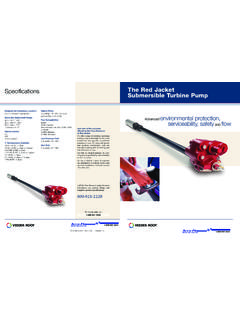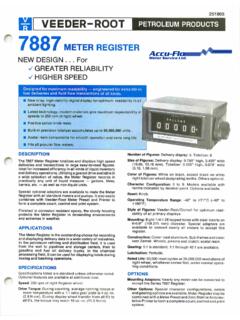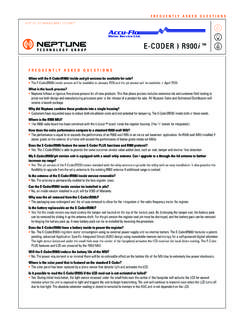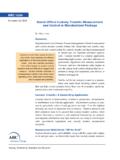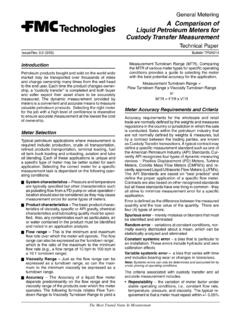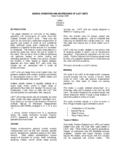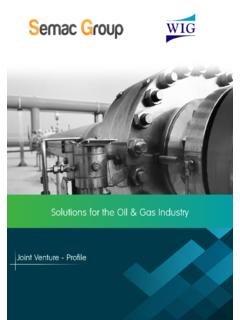Transcription of POSITIVE DISPLACEMENT ETERS - Accu-Flo Meter …
1 POSITIVE DISPLACEMENT METERS FOR LIQUID MEASUREMENT AUTHORIZED DISTRIBUTOR: Oscillating Pis-Rotary Lobe Reciprocating Pis-Rotary Lobe Rotary Vane Helical Rotor Rotary Gear Rotary Vane Rotary Vane Nutating Disc OVERVIEW Total Control Systems is a manufacturer of flow measurement systems for the custody transfer. This technical document is to examine the posi-tive DISPLACEMENT (PD) flow Meter design princi-ples, indicating and recording elements and flow control elements used within typical metering systems. Typical illustrations of metering sys-tems will then discussed on how to achieve the best accurate performance. HISTORY PD meters have been in existed for more than a century. By the late 1930 s, PD meters were used extensively in custody transfer measure-ment applications, such as service stations, tank trucks, loading terminals and pipelines.
2 Throughout history, PD meters have proven to be the most accurate means of petroleum measurement in the industry because of their high accuracy, stability; volume directly meas-ured, low pressure loss and the ability to meas-ure liquids without flow conditioning. PD Meter PRINCIPLE Most PD meters consist of the Housing and Measurement Element. Housing The housing serves as the pressure vessel in which contains the Measurement Element. It must have an inlet and outlet connection, to channel liquid through the measurement ele-ment. Housing pressure ratings vary dependent on the design, metallurgy and system pres-sures. Housings can be either a single or dual case construction. In a single case construction, the housing serves as both pressure vessel and measuring element.
3 In the double case con- struction, the measurement element is sur-rounded by a separate external housing. Measurement Chamber The measuring chamber (element) is the design principle of the PD Meter . The liquid volume is separated into a known quantity as it flows through the measuring chamber. Each measurement chamber will have its own unique characteristics, including Accuracy, Fric-tion Loss, Pressure Drop, Debris Tolerance, Driving Torque and Size/Weight. The following are examples of POSITIVE Displace-ment measurement principles. TCS900023/R10 Reciprocating Piston Rotary Piston Page 1 Meter Selection In order to chose the correct PD Meter for a product application, you must first consider the product characteristics and system conditions. Information regarding the product characteris-tics can be further reviewed in the TCS Engi-neering Manuals to help determine the correct flow Meter .
4 A) Material Compatibility The product intended to be measured must be evaluated to find suitable material compatible to handle the fluid correctly. Materials incompati-ble with product will potentially reduce accura-cy, operation life, contaminate liquid and may be harmful to others. B) Flow Rate The minimum and maximum system rate of flow must be determined for the selection of flow Meter . The flow rate of the system is depend-ent upon the product viscosity, the desired me-ter configuration, the systems pump capabili-ties, and the plumbing configuration. C) Pressure The maximum working pressure allowed should be reviewed under flow Meter type and pressure rating. Failure to adhere to the maximum al-lowable pressure may potentially cause a seal leak or casting rupture.
5 D) Temperature The operating temperature has a great effect on the Meter seals and its relationship to the maxi-mum pressure allowed with the flow Meter cast-ings. It will be necessary to reduce the maxi-mum rated working pressure as the operating temperature increases. Any metering system operating over 160F (71C) will require extra clearance rotors to compensate for material ex-pansion. Any metering system operating over 180F (82 C) will require at least a one (1) foot registration extension to protect the registration devices. Increase in temperature may increase the corrosion rate of some products. E) Lubricity The lubricity or non-lubricity of the product will determine the bearing material suitable for use. Products with no lubrication will require the use of Carbon Graphite, Teflon or Ceramic bearings.
6 Products with lubrication will reduce friction be-tween two metal surfaces and help dissipate heat. F) Foreign Materials Products that are to be measured may have for-eign materials present. The inlet side of any POSITIVE DISPLACEMENT Meter should be equipped with a strainer. Matching the strainer size or one size larger, with an appropriate size screen will protect the Meter and accessories from damage in the system. A minimum of 40-mesh screen is recommended for petroleum service. A mini-mum of 100-mesh screen is recommended for liquefied petroleum gas. G) Suspensions & Suspended Solids Products with a low percentage of soft suspen-sions or suspended solids will require clearance rotors and/or Ceramic bearings to protect from its abrasive effects. Due to the very tight ma-chining tolerances in the 700 rotary Meter , any solid larger than the thickness of a piece of pa-per, has the potential of stopping the flow and can cause damage to the Meter .
7 High percent-ages (5%) of suspensions or suspended solids, or any hard solids, such as sand, are not recom-mended. Some suspended solids are acceptable for the 682 piston Meter . H) pH The metal resistance to the effects of high or low PH varies because of the chemical s differ-ent concentrations and corrosive properties. See Engineering Guide for assistance. I) Viscosity Viscosity is the property of a fluid that is a measure of its resistance to flow. Among the earliest to express this quantitatively was Sir Isaac Newton. He reasoned that the viscosity of a liquid was proportional to its shear stress (or resistance to shear). Liquids that behave in this manner are referred to as Newtonian liquids and are typically petroleum fluids, water and similar chemicals.
8 J) Pressure Loss The pressure drop is the difference between of the inlet and outlet pressure of the flow Meter while operating. When measuring a liquid, the pressure drop will increase as the flow rate in-creases. When the metering system has acces-sories such as an air eliminator or valve, these items will be approximately the same pressure drop through equivalent size Meter . TCS900023/R10 Page 2 The product viscosity will also have a direct re-lationship on the flow rate of the system. The higher viscous fluid, the higher the pressure loss. If the metered product has a high viscosi-ty, it will be necessary to decrease the flow rate of the Meter to reduce the strain on the flow Meter . K) Products that Dry/Congeal/Crystallize There are many liquids that crystallize, harden and/or solidify on contact with air or with an in-crease in temperature.
9 A proper system design and a good understanding of the product being measured will help to avoid the possibility of air entering into the system and the product being affected. INDICATING & RECORDING ELEMENT Each measuring chamber will provide a mechan-ical output to display the flow indication and re-cording element. There are three basic methods or devices used for the flow data output: me-chanical registration, a pulse output transmitter and electronic flow computers. Mechanical Registration The mechanical register counters are designed to calculate the PD Meter output into a volumet-ric measurement. A gear ratio calculates the known volume measurement into a unit of measure (Gallons, Liters, Dekaliters, etc.). Each PD Meter has a Calibration Adjuster, whether internal or external to the Meter as-sembly.
10 This Calibration Adjuster will make fine adjustments to the volume measurement of the PD Meter , changing the Mechanical Register vol-ume measurement to the known liquid volume measurement. Pulse Transmitter The Pulse Transmitter was designed to provide accurate pulse output signal for remote indica-tion, totalizers and data monitoring systems. A pulse output is the conversion of the mechani-cal rotation of the flow Meter into a precise ratio of electronic pulses per volume. A shaft encod-er transmits the single or dual channel (quadrature) square wave frequency. An over-lapping (quadrature) output permits the detec-tion of direction of rotation and errors on either channel but not both concurrently. The single channel devices are used when greater pulse density is desired and error detection is not re-quired.

